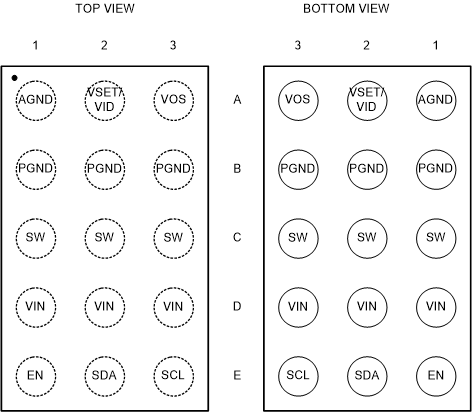SLVSEI1C June 2019 – October 2020 TPS62864 , TPS62866
PRODUCTION DATA
- 1 Features
- 2 Applications
- 3 Description
- 4 Revision History
- 5 Device Options
- 6 Pin Configuration and Functions
- 7 Specifications
- 8 Detailed Description
- 9 Application and Implementation
- 10Power Supply Recommendations
- 11Layout
- 12Device and Documentation Support
- 13Mechanical, Packaging, and Orderable Information
Package Options
Refer to the PDF data sheet for device specific package drawings
Mechanical Data (Package|Pins)
- YCG|15
Thermal pad, mechanical data (Package|Pins)
Orderable Information
6 Pin Configuration and Functions
 Figure 6-1 YCG (15 Pin)
Figure 6-1 YCG (15 Pin)Table 6-1 Pin Functions
| PIN | DESCRIPTION | |
|---|---|---|
| NAME | NO. | |
| AGND | A1 | Analog ground pin |
| VSET/VID | A2 | Start-up output voltage and device address selection pin. An external resistor must be connected. After start-up, the pin can be used to select the VOUT registers for the output voltage. (Low = VOUT register 1; High = VOUT register 2). See Section 8.4.4. |
| VSET/ PG | A2 | Start-up output voltage and device address selection pin. An external resistor must be connected. After start-up, the pin is used for the power good indicator. When the output voltage is not regulated, the pin is driven high. When the output voltage is regulated, the pin is pulled low through the external resistor. The function after start-up depends on the device option. See Section 5. |
| VOS | A3 | Output voltage sense pin. This pin must be directly connected to the output capacitor. |
| PGND | B1,B2,B3 | Power ground pin |
| SW | C1,C2,C3 | Switch pin of the power stage |
| VIN | D1,D2,D3 | Power supply input voltage pin |
| EN | E1 | Device enable pin. To enable the device, this pin needs to be pulled high. Pulling this pin low disables the device. Do not leave floating. |
| SDA | E2 | I2C serial data pin. Do not leave it floating. Connect it to AGND if not used. |
| SCL | E3 | I2C serial clock pin. Do not leave it floating. Connect it to AGND if not used. |